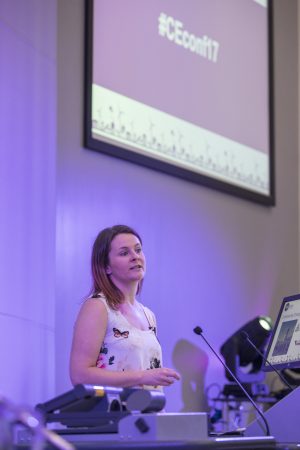After record levels of community energy activity in 2016, the sector’s growth has been stalled by the lack of subsidies.
Community Energy England’s first State of the Sector report shows how community energy projects, which include a number of co-ops, contribute to the nation’s energy supply.

Presenting the findings of the report at the Community Energy Conference in Manchester, chief executive Emma Bridge said that overall, electricity generated by the community energy sector had seen rapid growth but data in the report would not have shown the full impact of cuts.
There are 222 community energy organisations across England, Wales and Northern Ireland, the majority of them social enterprises.
Around 44% of these are community benefit societies and 22% are co-operatives. Co-ops and community benefit societies ensure their members have voting rights, giving individuals the chance to be active owners, rather than passive investors.
According to the report, community energy projects provide over 121 megawatts of low-carbon energy capacity, reducing energy use across 74 communities. In total, the study found that community energy organisations generated £620,000 for their community benefit funds over the 12 months to 2017, across 52 organisations.
One of these is the Schools’ Energy Co-operative, launched in 2014 to provide community sources funding for solar panel systems on schools throughout England. The co-op has gone on to install panels on 27 schools, totalling over 1 MW of generation capacity, with projects financed through a share offer. As well as providing fixed price electricity to schools at reduced rates, the co-op also distributes its profits between the participating schools.
Related: Co-op Energy can be the ‘jewel in the crown’ for the movement, says David Bird
To reduce financial risks, community groups are looking at identifying partnerships and joint venture opportunities with private and public entities. In Brighton a co-op is looking to tackle transport solution by using solar powered electric busses.
Speaking at the conference, Will Cottrell from Brighton Energy Co-op explained how the 120 solar panels would generate 30,000kWh of electricity – the equivalent of 1.8 million kettle boils. The initiative is a joint project between the co-op, Sussex Backup and the Big Lemon. Their bid has been shortlisted for a share of the M&S Community Energy Fund, to cover the roof of The Big Lemon’s bus depot in solar panels.
Changes over the last two years have seen reduction of the feed-in tariffs, removal of Enterprise Investment Scheme (EIS), Seed Enterprise Investment Scheme (SEIS) tax reliefs and the removal of Renewables Obligation, all impacting on the growth of the community energy sector.
Of the total 144 organisations surveyed for Community Energy England’s report, 44 have a project considered stalled or inactive. Of these, 48% said that feed-in tariff changes were a major barrier to the project, with 34% also noting capital finance (FiT) barriers, often as a result of a lack of subsidy support. Other barriers mentioned included planning issues (25%), engineering issues (11%), lack of expertise and local opposition (7%).
Furthermore, 36 organisations said that reinstatement of viable FiT levels or the creation of community specific support or subsidies are essential in enabling communities to realise their energy objective.
“Establishing any energy industry requires public sector commitment. The support demanded by the community energy sector is extremely modest but it is vital. We need fair tax relief, a planning review and full and fair access to energy markets so we can play out full part in the move to a decentralised energy system and meeting the nation’s energy needs,” said Ms Bridge.

In January Community Energy England (CEE) launched a policy subgroup of community energy directors and experts who explore policy issues. Speaking at a separate workshop at the conference, chair of the subgroup, Paul Monaghan, encouraged delegates to help shape policies that may have an impact on the sector.
Community Energy England has responded to a consultation launched by the UK government in 2016 looking at evidence for a smart, flexible energy system. Community energy groups have the advantage of being trusted by the public, said Mr Monaghan.
He added that EU level an energy market is emerging following the union’s energy directives it the UK would likely be part of it even in the context of Brexit. If the EU’s first renewable energy directive did not mention consumer producers – or prosumers, the second directive launched just before Christmas creates a right for every EU citizen to create community energy right across Europe.
CEE also plans to get involved in shaping the government’s industrial strategy as well as the policy around housing.
Mr Monaghan added that the CEE would work to promote the reintroduction of tax relief for community energy schemes, solar PV community energy systems excluded from PV rates and a review of planning rules affecting wind, solar and hydro projects.
CEE will continue to lobby for co-operatives and community benefit societies to gain access to Social Investment Tax Relief (STIR), confirmed Mr Monaghan.
“We haven’t given up, we think there is a case for genuine co-ops and community benefit societies to gain access to SITR,” he said.
CEE is also collaborating with other organisations including Oxfam and Christian Aid to raise awareness over common concerns. The Community Energy Fortnight, which is celebrated on 24 June – 9 July, coinciding with the Climate Coalition’s week of action, on the first week of July. The collaboration aims to boost knowledge about clean renewable energy initiatives.
“The idea that the public is against community energy is false. We’ve won the argument, only a minority of people oppose community energy,” said Mr Monaghan, adding that new figures due to be released by Co-operative Energy this week would confirm wide public support for community energy initiatives.

